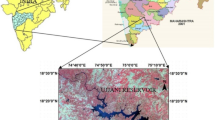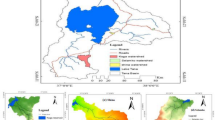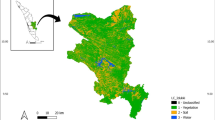Abstract
Reservoir sedimentation is the gradual accumulation of incoming sediments from upstream catchment leading to the reduction in useful storage capacity of the reservoir. Quantifying the reservoir sedimentation rate is essential for better water resources management. Conventional techniques such as hydrographic survey have limitations including time-consuming, cumbersome and costly. On the contrary, the availability of high resolution (both spatial and temporal) in public domain overcomes all these constraints. This study assessed Jayakwadi reservoir sedimentation using Landsat 8 OLI satellite data combined with ancillary data. Multi-date remotely sensed data were used to produce the water spread area of the reservoir, which was applied to compute the sedimentation rate. The revised live storage capacity of the reservoir between maximum and minimum levels observed under the period of analysis (2015–2017) was assessed utilizing the trapezoidal formula. The revised live storage capacity is assessed as 1942.258 against the designed capacity of 2170.935 Mm3 at full reservoir level. The total loss of reservoir capacity due to the sediment deposition during the period of 41 years (1975–2017) was estimated as 228.677 Mm3 (10.53%) which provided the average sedimentation rate of 5.58 Mm3 year1. As this technique also provides the capacity of the reservoir at the different elevation on the date of the satellite pass, the revised elevation–capacity curve was also developed. The sedimentation analysis usually provides the volume of sediment deposited and rate of the deposition. However, the interest of the reservoir authorities and water resources planner’s lies in sub-watershed-wise sediment yield, and the critical sub-watersheds upstream reservoir requires conservation, etc. Therefore, in the present study, Soil and Water Assessment Tool (SWAT) was used for the estimation of sediment yield of the reservoir. The average annual sediment yield obtained from the SWAT model using 36 years of data (1979–2014) was 13.144 Mm3 year−1 with the density of the soil (loamy and clay) of 1.44 ton m−3. The findings revealed that the rate of sedimentation obtained from the remote sensing-based methods is in agreement with the results of the hydrographic survey.






Similar content being viewed by others
References
Abebe, Z. D., & Sewnet, M. A. (2014). Adoption of soil conservation practices in North Achefer District, Northwest Ethiopia. Chinese Journal of Population Resources and Environment, 12(3), 261–268.
Arnold, J. G., Srinivasan, R., Muttiah, R. S., & Williams, J. R. (1998). Large area hydrologic modelling and assessment part I: Model development. JAWRA Journal of the American Water Resources Association, 34(1), 73–89.
Ayana, A. B., Edossa, D. C., & Kositsakulchai, E. (2012). Simulation of sediment yield using SWAT model in Fincha Watershed, Ethiopia. Kasetsart Journal: Natural Science, 46, 283–297.
Barsi, J. A., Lee, K., Kvaran, G., Markham, B. L., & Pedelty, J. A. (2014). The spectral response of the landsat-8 operational land imager. Remote Sensing, 6, 10232–10251.
Betrie, G. D., Mohamed, Y. A., van Griensven, A., & Srinivasan, R. (2011). Sediment management modelling in the Blue Nile Basin using SWAT model. Hydrology and Earth System Sciences, 15(3), 807.
Borland, W. M., & Miller, C. R. (1960). Distribution of sediment in large reservoirs. Transactions of the American Society of Civil Engineers, 125(1), 166–180.
Cristofano, E. A. (1953). Area increment method for distributing sediment in a reservoir. Albuquerque: US Bureau of Reclamation.
Dendy, F. (1982). Distribution of sediment deposits in small reservoirs. Transactions of the ASAE, 25(1), 100–0104.
Goel, M., & Jain, S. K. (1996). Evaluation of reservoir sedimentation using multi-temporal IRS-1A LISS II data. Asian-Pacific Remote Sensing and GIS Journal, 8(2), 39–43.
Goel, M., Jain, S. K., & Agarwal, P. (2002). Assessment of sediment deposition rate in Bargi Reservoir using digital image processing. Hydrological Sciences Journal, 47(S1), S81–S92.
Ijam, A., & Al-Mahamid, M. (2012). Predicting sedimentation at Mujib dam reservoir in Jordan. Jordan Journal of Civil Engineering, 6(4), 448–463.
Ijam, A. Z., & Tarawneh, E. R. (2012). Assessment of sediment yield for Wala dam catchment area in Jordan. European Water, 38, 43–58.
Jagadeesha, C. J., & Palnitkar, V. G. (1991). Satellite data aids in monitoring reservoir water and irrigated agriculture. Water International, 16(1), 27–37.
Jain, S. K., & Goel, M. (2002). Assessing the vulnerability to soil erosion of the Ukai Dam catchments using remote sensing and GIS. Hydrological Sciences Journal, 47(1), 31–40.
Jain, S. K., Singh, P., & Seth, S. (2002). Assessment of sedimentation in Bhakra Reservoir in the western Himalayan region using remotely sensed data. Hydrological Sciences Journal, 47(2), 203–212.
Jain, S. K., Tyagi, J., & Singh, V. (2010). Simulation of runoff and sediment yield for a Himalayan watershed using SWAT model. Journal of Water Resource and Protection, 2(03), 267.
Jeyakanthan, V., & Sanjeevi, S. (2013). Capacity survey of Nagarjuna Sagar reservoir, India using Linear Mixture Model (LMM) approach. International Journal of Geomatics and Geosciences, 4(1), 186.
Jorgensen, S. E., Loffler, H., Rast, W., & Straskraba, M. (2005). Lake and reservoir management (Vol. 54). Amsterdam: Elsevier.
Mandwar, S. R., Hajare, H. V., & Gajbhiye, D. A. R. (2013). Assessment of capacity evaluation and sedimentation of Totla Doh Reservoir, in Nagpur district by remote sensing technique. IOSR Journal of Mechanical and Civil Engineering (IOSR-JMCE), 4(6), 22–25.
McFeeters, S. K. (1996). The use of the Normalized Difference Water Index (NDWI) in the delineation of open water features. International Journal of Remote Sensing, 17(7), 1425–1432.
Merina, N. R., Sashikkumar, M., Rizvana, N., & Adlin, R. (2016). Sedimentation study in a reservoir using remote sensing technique. Applied Ecology and Environmental Research, 14(4), 296–304.
Michalec, B. (2008). Ocena intensywności procesu zamulania małych zbiorników wodnych w dorzeczu Górnej Wisły. [An assessment of siltation of small water reservoirs in the Upper Vistula River catchment]. Zeszyty Naukowe Uniwersytetu Rolniczego im. Hugona Kołłątaja w Krakowie. Rozprawy (328), 193.
Mishra, A., Froebrich, J., & Gassman, P. W. (2007). Evaluation of the SWAT model for assessing sediment control structures in a small watershed in India. Transactions of the ASABE, 50(2), 469–477.
Mukherjee, S., Veer, V., Tyagi, S. K., & Sharma, V. (2007). Sedimentation study of Hirakud reservoir through remote sensing techniques. Journal of Spatial Hydrology, 7(1), 122–130.
Mutchler, C. K., Murphee, C. E., & McGregor, K. C. (1988). Laboratory and field plots for soil erosion studies. In: Lal R. (Ed.), Soil erosion research methods. Soil and Water Conservation Society, Ankney, Iowa.
Narasayya, K. (2013). Assessment of reservoir sedimentation using remote sensing satellite imageries. Asian Journal of Geoinformatics, 12(4), 1–9.
Ndomba, P. M., & van Griensven, A. (2011). Suitability of SWAT Model for Sediment Yields Modelling in the Eastern Africa. In D. Chen (Ed.), Advances in data, methods, models and their applications in geoscience. Rijeka: IntechOpen.
Neitsch, S. L., Arnold, J. G., Kiniry, J. R., & Williams, J. R. (2005). Soil and water assessment tool theoretical documentation. Ver. 2005. Temple, Tex.: USDA‐ARS Grassland Soil and Water Research Laboratory, and Texas A&M University, Blackland Research and Extension Center.
Randolph, J. (2004). Environmental land use planning and management. Washington: Island Press.
Rathore, D. S., Choudhary, A., & Agarwal, P. K. (2006). Assessment of sedimentation in harakud reservoir using digital remote sensing technique. Journal of the Indian Society of Remote Sensing, 34, 377–383.
Setegn, Shimelis G., Dargahi, Bijan, Srinivasan, Ragahavan, & Melesse, Assefa M. (2010). Modeling of sediment yield from Anjeni-Gauged watershed, Ethiopia using SWAT model. Journal of the American Water Resources Association (JAWRA), 46(3), 514–526. https://doi.org/10.1111/j.1752-1688.2010.00431.x.
Smith, S. E., Mancy, K. H., & Latif, A. F. A. (1980). The application of remote sensing techniques towards the management of the Aswan high dam reservoir. In International symposium on remote sensing of environment, 14 th, San Jose, Costa Rica (pp. 1297–1307).
Sumantyo, J. T. S., Shimada, M., Mathieu, P. P., Sartohadi, J., & Putri, R. F. (2012). Dinsar technique for retrieving the volume of volcanic materials erupted by Merapi volcano. In Geoscience and remote sensing symposium (IGARSS), 2012 IEEE international (pp. 1302–1305). IEEE.
Tamene, L., Park, S., Dikau, R., & Vlek, P. (2006). Analysis of factors determining sediment yield variability in the highlands of northern Ethiopia. Geomorphology, 76(1–2), 76–91.
Tyagi, J., Rai, S., Qazi, N., & Singh, M. (2014). Assessment of discharge and sediment transport from different forest cover types in lower Himalaya using soil and water assessment tool (SWAT). International Journal of Water Resources and Environmental Engineering, 6(1), 49–66.
Vemu, S., & Udayabhaskar, P. (2010). An integrated approach for prioritization of reservoir catchment using remote sensing and geographic information system techniques. Geocarto International, 25(2), 149–168.
Vibulsresth, S., Srisangthong, D., Thisayakorn, K., Suwanwerakamtorn, R., Wongparn, S., Rodparm, C., et al. (1988). The reservoir capacity of Ubolratana dam between 173 and 180 meters above mean sea level. Asian-Pacific Remote Sensing Journal, 1(1), 1–10.
Vishwakarma, Y., Tiwari, H., & Jaiswal, R. (2015). Assessment of reservoir sedimentation using remote sensing technique with GIS model—A review. International Journal of Engineering and Management Research (IJEMR), 5(3), 411–417.
Wang, X., Shao, X., & Li, D. (2003). Sediment deposition pattern and flow conditions in the Three Gorges Reservoir: A physical model study. Tsinghua Science and Technology, 8(6), 708–712.
Williams, J. R. (1975). Sediment-yield prediction with universal soil loss equation using runoff energy factor. In Present and prospective technology for predicting sediment yields and sources (pp. 244–252). Oxford, MS: Proceedings of the Sediment Yield Workshop.
Xu, Z. X., Pang, J. P., Liu, C. M., & Li, J. Y. (2009). Assessment of runoff and sediment yield in the Miyun Reservoir catchment by using SWAT model. Hydrological Processes, 23(25), 3619–3630.
Yeo, I. Y., Lang, M., & Vermote, E. (2014). Improved understanding of suspended sediment transport process using multi-temporal Landsat data: A case study from the Old Woman Creek Estuary (Ohio). IEEE Journal of Selected Topics in Applied Earth Observations and Remote Sensing, 7(2), 636–647.
Author information
Authors and Affiliations
Corresponding author
About this article
Cite this article
Foteh, R., Garg, V., Nikam, B.R. et al. Reservoir Sedimentation Assessment Through Remote Sensing and Hydrological Modelling. J Indian Soc Remote Sens 46, 1893–1905 (2018). https://doi.org/10.1007/s12524-018-0843-6
Received:
Accepted:
Published:
Issue Date:
DOI: https://doi.org/10.1007/s12524-018-0843-6




